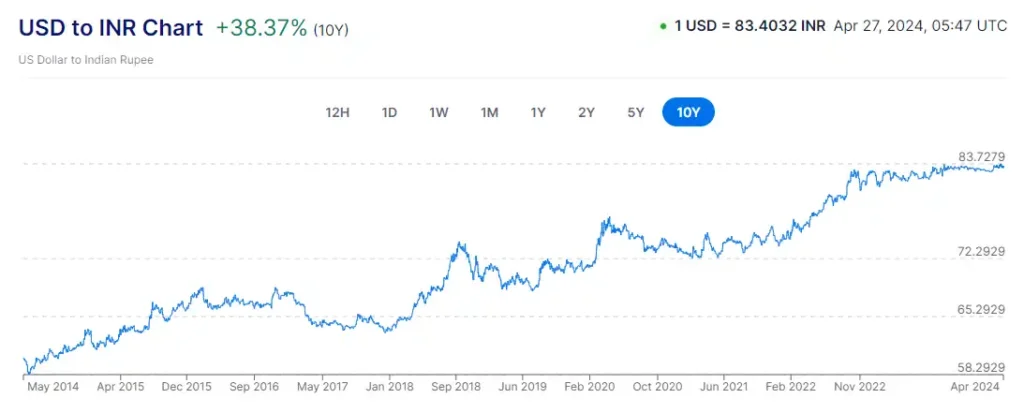For any nation, the depreciation of their currency can have far-reaching effects on its economy as well as trade relationships. When we talk about the Indian rupee, its fluctuating value against major foreign currencies has been a matter of concern and interest for the policymakers, entities and the general masses in India. In the year of 2022, the Indian rupee was given the title of ‘the worst performing Asian currency’.
In this article, we will discuss why the depreciation of the Indian rupee takes place and its implications on the Indian economy.
Why Does Indian Rupee Depreciate?
When we say ‘Rupee depreciation’, we refer to the fall in the value of Indian rupee against the dollar. The rupee depreciation suggests that the rupee has become weaker and less valuable against the dollar. Let us take an example: if the value of 1 US dollar increases from Rs. 80 to Rs. 85, the change will be termed as ‘depreciation of Indian rupee’.
According to the Business Standard, “The rupee has depreciated by 0.16 per cent in the current financial year, while, in the current calendar year, it has weakened by 0.4 per cent against the greenback. In the previous financial year, it witnessed a depreciation of 1.5 per cent over the year.”
There are several reasons for the fall of the Indian currency such as the following:
- The first reason is that the Indian economy is not performing as well as other countries. As a result, investors are shifting their money to better performing countries.
- Due to the ongoing inflation, the Government of India is finding it difficult to control the Indian currency.
- As an attempt to try and keep the Indian rupee stable, the central bank has raised interest rates. However, this has made it difficult for citizens to afford loans. This means that they have less disposable income in general.
- The primary source of India’s currency crisis is the rising current account deficit along with other contributing factors. The amount of India’s income spent on importing goods and services from overseas rather than earning money from exports is measured by the current account deficit.
- The global economic downturn has reduced demand for the Indian exports and increased competition from other countries which manufacture similar products at lower costs than India. This is another factor which contributes to the Indian rupee crisis.
- India’s inflation rate continues to climb. This indicates that the rupee’s buying power is lessening. This suggests that the consumers now are required to spend a larger portion of their income on the same quantity of products and services they purchased/availed previously. This is reflected in the lower value of the currency – a lower currency value means that individuals will be able to purchase less with it than they previously could.
- The demand for Indian goods and services has decreased in recent years. This has contributed to the slowing down of the economy of India. Fewer jobs are being created in the country as compared to the past because of this decline. Due to this more people are unemployed or underemployed which reduces their ability to spend money on necessities like food, clothing and shelter. As a result, fewer people are using their income to purchase these goods and services.
- Since many investors no longer feel that buying Indian equities will provide them with a strong Return on Investment (ROI), the foreign investment has declined in India over time.
Formula to Calculate Currency Depreciation
Using the formula below, you can easily calculate currency depreciation:
Formula: Depreciation % = ((Old Exchange Rate – New Exchange Rate) / Old Exchange Rate) * 100
Let us show you how this formula works:
- First, you need to subtract the new exchange rate from the old exchange rate to determine their difference.
- To find out the percentage of change, you need to now divide this difference by the old exchange rate.
- Finally, to describe the difference as a percentage, you have to multiply this proportion by 100.
Now, let’s consider the Indian Rupee (INR) against the US Dollar (USD) as an example. If the old exchange rate was 80 INR per USD and the new exchange rate is 85 INR per USD:
Formula: Depreciation % = ((80 – 85) / 80) * 100 = (-5 / 80) * 100 = – 6.25 %
According to this currency depreciation formula, the Indian Rupee has depreciated by roughly 6.25% against the US Dollar.
Depreciation of Indian Rupee in a Decade
The chart below shows how the Indian rupee has depreciated over the past 10 years:

Impact of Indian Rupee Depreciation
Indian Rupee’s devaluation has numerous impacts on the different areas of the country’s economy. Let’s discuss them below:
- Importers have to spend more rupees to obtain the same amount of foreign currency (generally USD). Hence, the imports have become more expensive due to the decline in rupee. This results in higher prices for imported goods and services which have an impact on consumers and import-dependent sectors.
- Due to the rising import costs, the overall price levels of the nation are impacted by domestic inflation. The growing inflation may impact the consumer’s purchasing power and disrupt the economic stability of the country.
- Due to the depreciation, the imports have become more expensive. This has widened the current account deficit of India.
- Since the rupee has become weaker, Indian exports can be more competitive in global markets. Industries which are export-oriented, like IT and pharmaceutical companies, can benefit from their products and services’ increased demand.
- Due to the depreciation, foreign investors may pull their investments back from the Indian markets which might result in decline in stock and equity mutual fund investments. This can have an impact on the financial markets and capital flows of India.
- India depends on imports of oil and gas heavily. A depreciating rupee has a negative impact on the cost of these imports and leads to a hike in energy prices for consumers.
- It has become challenging for the RBI to maintain low-rates since a depreciating rupee can attract imported inflation pressures.
Can any Measures be Taken to Halt Rupee Depreciation?
The rupee depreciation is a major concern which is influenced by many global and domestic factors. To mitigate its effect, there are several measures which can be considered by the policymakers such as:
- By encouraging the foreign central banks, endowment funds and sovereign wealth funds to invest in Indian government bonds, the GOI can help to stabilize capital flows which can strengthen the Indian rupee.
- The foreign exchange reserves can be used by RBI strategically for managing the volatility of the currency. The Indian Rupee’s value can be stabilized by selling foreign currency reserves.
- India’s trade balance can be improved by increasing export incentives and reducing the dependency on import. This will help to reduce the pressure on the Indian rupee.
- Domestic manufacturing must be boosted by the central government and state governments as this can help to reduce the reliance on imports, especially for critical goods.
- The use of rupee for international trade transactions should be promoted as this can reduce the demand for US dollars which can lead to stability in the value of Indian rupee in the global markets.
- More schemes and initiatives must be rolled out for encouraging NRIs to invest in India. These schemes and initiatives can offer attractive interest rates on NRIs’ deposits. Doing this can direct more foreign currency into the country.
- The RBI must continue to focus on the effective management of interest rates to help in balancing the economic growth and controlling the inflation. A sustainable equilibrium should be the aim of the RBI.
Reserve Bank of India’s Role in Ensuring Stability in Rupee’s Value
An important role is played by the Reserve Bank of India (RBI) or the central bank when it comes to monitoring or managing the foreign exchange market for ensuring rupee value’s stability. Whenever excessive volatility is detected by RBI, it intervenes in the market.
RBI has taken various actions to reduce volatility and ensure stability in Rupee’s value:
- RBI has lowered restrictions on the government bonds’ foreign ownership.
- It has increased the borrowing limits for businesses.
- To reduce the US dollar dependency, RBI has proposed rupee settlement methods in international trade.
Conclusion
For any economy, a depreciating currency is not a healthy scenario. Especially for a developing country like ours. The depreciating Indian rupee is a major concern and the GOI and RBI are taking several measures to rectify this situation. India is viewed as one of the fastest growing economies in the world, even in the post-pandemic and ongoing war predicament. Hopefully, the Indian rupee will see a decline in its depreciation rate with time. If you enjoyed reading this blog post, do check out the rest of our equally-interesting blog posts.
Frequently Asked Questions (FAQs)
Q1. What is Rupee Depreciation?
Rupee depreciation refers to the fall in the value of Indian rupee against the dollar. The rupee depreciation suggests that the rupee has become weaker and less valuable against the dollar.
Q2. Which currency has the highest-value in the world?
Kuwaiti Dinar
Q3. Why is the US dollar so powerful?
The US dollar is strong owing to the strength of the US economy, safety provided by the dollar due to the low risks, its function as a petrodollar (US dollars paid to an oil-exporting country) and its status as the world’s reserve currency.

